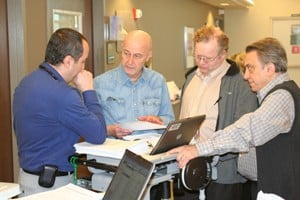UAMS Researchers Uncover Differences in High-Risk Myeloma Cases
| July 13, 2010 | Fourteen genes may offer clues as to why multiple myeloma is more aggressive for some patients than for others, say researchers at the University of Arkansas for Medical Sciences (UAMS) Myeloma Institute for Research and Therapy. After first identifying types of multiple myeloma – a cancer of the blood’s plasma cells – that were more aggressive (high risk) and less aggressive (low risk), UAMS myeloma researchers are now looking at variations of patient outcomes within high-risk groups. Median survival for the roughly 15 percent of patients with high-risk myeloma is about two years, versus 10 years for those identified with low-risk myeloma. Within the high-risk group, researchers found some patients who had an “ultra” high-risk version of the disease while others responded to treatment despite being classified with the high-risk type. Further genetic analysis revealed 14 genes that were differently expressed between the two groups. Those 14 genes could be what differentiate between the ultra high-risk cases and those high-risk cases that respond to therapy and also could offer targets for new treatment plans. Myeloma researchers, led by Myeloma Institute director Bart Barlogie, M.D., Ph.D., presented these latest findings at the annual meeting of the American Association of Clinical Oncology in Chicago, June 4-6. “We are continuing to peel away the layers of the onion that is multiple myeloma,” Barlogie said. “The continued successful response to treatment in low-risk myeloma offers an enormous paradigm shift in multiple myeloma and we move from what we consider a no-cure situation to having a cure.” Barlogie was lead author of “Defining the prognostic variables in gene expression profiling (GEP)-defined high-risk multiple myeloma (MM): Distinguishing early failures (EF) from sustained control (SC)” that discusses the differences in high-risk cases. Other Myeloma Institute faculty authors on the research included John D. Shaughnessy Jr., Ph.D., director of the Donna D. and Donald M. Lambert Laboratory; Frits van Rhee, M.D., Ph.D., professor of medicine and director of clinical research; and Elias Anaissie, M.D., professor of medicine and director of supportive care at the Myeloma Institute. Joining the UAMS authors were Antje Hoering, Ph.D., senior biostatistician, Jeff Haessler, MS, biostatistician and John Crowley, Ph.D., president and chief executive officer, of Cancer Research and Biostatistics in Seattle. Read more here about other research presented at the conference. |
